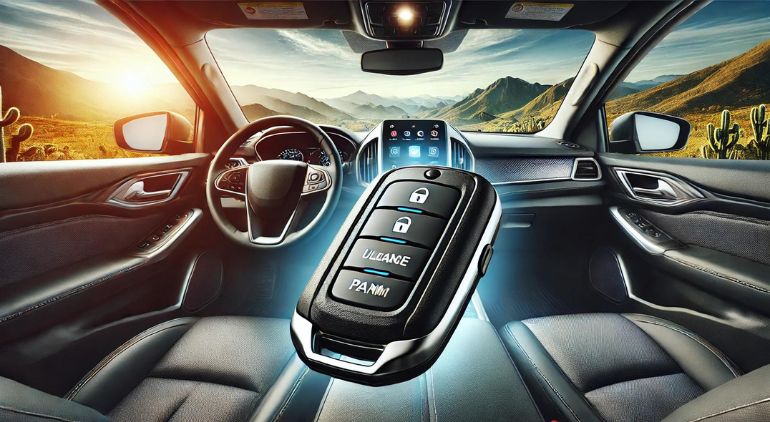405-458-5710
Confidentiality Guaranteed
405-458-5710
Confidentiality Guaranteed
You are Reading:
-
1 to 1 Risk Control & Investigations > Blog > Car Security > Why Car Lock Remotes Are Not as Easy to Hack as They Seem

Jul
Why Car Lock Remotes Are Not as Easy to Hack as They Seem
Understanding Car Lock Remotes: Car lock remotes, also known as key fobs, have become a standard feature in modern vehicles, providing convenience and enhanced security. These small devices allow drivers to lock and unlock their car doors, and sometimes even start the engine, with the push of a button. However, with the rise in automotive technology, concerns about the security of these systems have also increased. While it may seem like car lock remotes are easy targets for hackers, the reality is quite different.
The Technology Behind Car Lock Remotes: Car lock remotes operate using radio frequency (RF) technology. When the button on the remote is pressed, it sends a coded signal to the car’s receiver, which then performs the requested action, such as locking or unlocking the doors. This signal is encrypted to prevent unauthorized access. The complexity of the encryption makes it challenging for hackers to intercept and decode the signal.
Rolling Codes for Enhanced Security: One of the key features that make car lock remotes difficult to hack is the use of rolling codes. Unlike static codes that remain the same every time the remote is used, rolling codes change each time the button is pressed. This means that even if a hacker manages to capture the signal, it becomes useless for future attempts because the code will have changed. This dynamic encryption adds an extra layer of security, making it significantly harder for hackers to exploit the system.
Frequency Hopping: Another security measure employed by car lock remotes is frequency hopping. This technique involves changing the frequency of the signal with each transmission. By doing so, it prevents hackers from using RF jammers to block or interfere with the signal. Frequency hopping makes it more difficult for hackers to predict the signal frequency, thus reducing the chances of a successful attack.
Advanced Encryption Standards: Car lock remotes use advanced encryption standards (AES) to protect the signal from being intercepted and decoded. AES is a symmetric encryption algorithm that is widely used for securing sensitive data. The strength of AES encryption lies in its ability to convert plain text into an unreadable format, which can only be decrypted with a specific key. This high level of encryption ensures that the signal transmitted by the car lock remote remains secure and inaccessible to unauthorized individuals.
Potential Vulnerabilities: While car lock remotes are designed with robust security features, they are not entirely immune to vulnerabilities. One potential vulnerability is the relay attack. In a relay attack, hackers use two devices to capture and relay the signal from the car lock remote to the car. This type of attack requires the hacker to be in close proximity to both the remote and the car, making it a less common but still possible threat. However, advancements in car security are continually addressing and mitigating such vulnerabilities.
Improvements in Car Security: Automakers are constantly working to improve the security of car lock remotes. Newer models come equipped with enhanced encryption algorithms and additional security features to stay ahead of potential threats. Moreover, manufacturers regularly update their systems to patch any identified vulnerabilities, ensuring that car lock remotes remain secure against evolving hacking techniques.
User Awareness and Precautions: While technological advancements play a crucial role in securing car lock remotes, user awareness and precautions are equally important. Car owners should be mindful of their remote’s security and take steps to minimize risks. For instance, keeping the remote in a signal-blocking pouch or a Faraday cage when not in use can prevent hackers from capturing the signal. Additionally, regular software updates from the car manufacturer can enhance the security of the remote system.
Legal and Regulatory Measures: Governments and regulatory bodies are also involved in ensuring the security of automotive technology. There are stringent regulations and standards in place that automakers must comply with to ensure the safety and security of their vehicles. These regulations mandate the use of advanced encryption techniques and other security measures in car lock remotes, further reducing the likelihood of hacking.
The Role of Cybersecurity Experts: Cybersecurity experts play a vital role in identifying and addressing potential vulnerabilities in car lock remotes. These professionals conduct extensive research and testing to uncover any weaknesses in the system. Their findings help automakers enhance the security of their products and stay ahead of potential threats. Collaboration between automakers and cybersecurity experts is essential to maintaining the integrity of car lock remote systems.
The Future of Car Lock Security: As technology continues to evolve, so will the security measures employed in car lock remotes. Future advancements may include biometric authentication, such as fingerprint or facial recognition, to further enhance security. Additionally, the integration of blockchain technology could provide a tamper-proof record of all transactions, making it even more challenging for hackers to compromise the system. The ongoing commitment to innovation and security ensures that car lock remotes will remain robust against potential threats.
While car lock remotes may seem like easy targets for hackers, the reality is that they are equipped with advanced security features that make them difficult to hack. The use of rolling codes, frequency hopping, advanced encryption standards, and continuous improvements in car security contribute to the robustness of these systems. User awareness, legal regulations, and the efforts of cybersecurity experts further enhance the security of car lock remotes. As technology continues to advance, car lock remotes will continue to evolve, providing even greater protection against potential threats.
- AI
- Bug Sweeps
- Car Security
- Cyber Crime
- Cyber-Stalking
- Digital Forensics
- Fraud
- Geo-Political
- GPS Tracking
- Hidden Cameras
- Identity Theft
- Investigations
- Misinformation
- Mobile Device Forensics
- Mobile Device Security
- Operational Security
- Privacy
- Psychology
- Situational Awareness
- Social Media Investigations
- Stalking
- Surveillance
- Uncategorized
